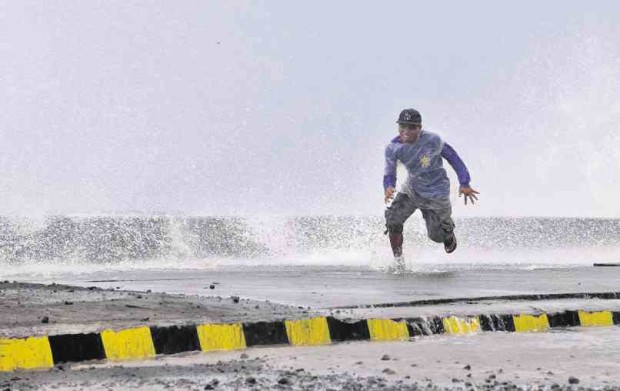Local weather terms to prevent disasters

A MAN avoids being drenched as strong waves whipped up by winds accompanying Typhoon “Nona” last year hit a sea wall along Legazpi City Boulevard in Albay province. MARK ALVIC ESPLANA / Inquirer Southern Luzon
When the wind suddenly turns cold at sea and dark clouds hover, it is time for fishermen to return to shore as turbulent waters are expected to occur.
This weather phenomenon is called “sobasko” in the coastal town of Calabanga in Camarines Sur province, said Charlie Capricho, a fisherman leader.
Capricho narrated this experience of interpreting signs in his environment to participants of a focused group discussion held recently at the Department of Agriculture (DA) regional office in Pili town, also in Camarines Sur.
The activity was part of a research under the DA’s Adaptation and Mitigation Initiatives in Agriculture Program, which aims to document commonly used terms and phrases in describing the occurrence of disasters, such as typhoons, flooding and dry spell.
Local words and idioms
Article continues after this advertisementDr. F. Charito Sebastian, who led the discussions, stressed the importance of using language commonly understood in a specific locality when communicating the occurrence and impact of a disaster.
Article continues after this advertisementThe participants cited instances when people might have heeded warnings of danger from a “storm surge” if the term used to describe the impending disaster was “tidal wave” (“taydal weyb,” as pronounced by some Bicolano).
The formal technical meaning is disregarded in favor of a commonly understood term.
Among the terms they revisited were local words and idioms that describe the strength of typhoons, speed of wind, temperature during the El Niño weather phenomenon, flooding, volume of water, level and behavior of floodwater, and disaster damage.
The terms pertaining to disaster, which the participants had earlier collected from other places, included descriptions of flooding, hot weather condition, and impact of a changing climate.
When floodwater rises in coconut-growing areas in the Bicol region and nearby Quezon province, people commonly refer to coconut trees to describe water level. “Langkaw nin niyog an baha” (Floodwater as high as a coconut tree), they would say in Bikol.
Known for their religiosity, the Bicolano people describe huge waves rolling down the shores as “Garo katedral an kadarakula kan alon” (Waves as huge as a cathedral).
To those born in the 1990s and after, as communication and information technology advance, the terms seemed to have been lost in the changing times, flooded by multimedia platforms using Tagalog-based Filipino or English available in their personal computers and other electronic gadgets, the participants agreed.
Randy Salazar, 20, who lives in the seaside village of Sibobo in Calabanga, could only imagine the description “cathedral” to refer to huge waves, but he never used it. He would just say, “darakulaon” (very big), to refer to the size of waves.
Salazar does not know what “sobasko” means.
A village mate, Eric San Juan, 18, said he understood the impact of disasters because people in the neighborhood would always evacuate whenever typhoons strike.
‘Right language’
Prof. Ana Marie Alfelor, project associate and language specialist at the University of the Philippines, said the discussions were meant to draw the right language in issuing disaster warnings from the participants and its dissemination to the provinces.
Alfelor said she also expected to come up with sets of local terms pertaining to disasters based on the experiences of farmers and fishermen speaking Ilocano, Kapampangan, Bikol, Waray-waray, Hiligaynon, Cebuano and Chavacano.
The project also aimed to influence policies on the language and content of disaster warnings, and the means of using these by government agencies and local governments, including fisherfolk whose communities are highly vulnerable to disasters.